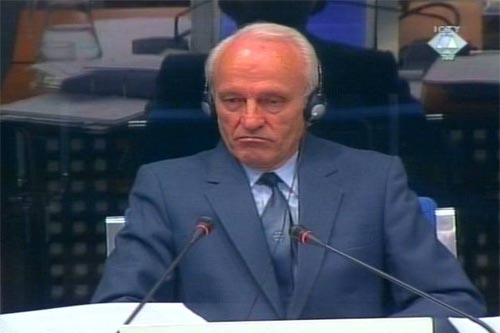Home
HOW DID THE BODIES FROM IZBICA ENDED UP AT PETROVO SELO?
In the course of the cross-examination of General Radomir Gojovic, the prosecutor presented a document establishing a link between human remains exhumed from a mass grave in Petrovo Selo in Serbia and the victims from Izbica in Kosovo. Milosevic demands that a determination be made as to “who did that and why” and “in whose interest it may have been to hide the bodies”
 Radomir Gojovic, witness in the Milosevic trial
Radomir Gojovic, witness in the Milosevic trial Slobodan Milosevic believes that UNMIK documents establishing a link between human remains exhumed from a mass grave in Petrovo Selo in Serbia and the victims from Izbica in Kosovo are "useful for the defense”. Noting that in late May 1999, after the discovery of 144 fresh graves in Izbica, the judiciary of the Yugoslav Army had the victims’ bodies exhumed and autopsied and instituted proceedings against “persons unknown”, Milosevic said he wanted to know “in whose it interest it may have been to remove the bodies and hide them somewhere,” and demands that a determination be made as to “who did it and why.”
Right at the beginning of the trial, Milosevic presented the argument that the refrigerated truck with the bodies that was found in the Danube and the mass graves in Batajnica, Petrovo Selo and Perucac were “set up” by the then Serbian authorities, in order to create an atmosphere in which he would be “abducted and illegally transferred to The Hague” in July 2001.
In the course of the cross-examination of General Radomir Gojovic, the prosecutor presented the document generated by UNMIK service for missing persons and forensic investigations. In the spring of 1999, Gojovic was the chief of the Legal Directorate of the VJ General Staff. The witness was offended by the prosecutor’s claim that in the course of the conflict in Kosovo the military judiciary, "when it came to serious crimes, was just window-dressing”. The allegations of serious crimes committed by VJ personnel were, as Nice claimed, “investigated only when there was no other choice”, and the bulk of what the military judicial system did in the spring of 1999 concerned “petty offences such as thefts of hair dryers, tape decks or cars.” The 'window-dressing' was necessary, as Nice said, because after numerous warnings by the international community that crimes were committed in Kosovo, “an impression had to be created that the Yugoslav Army was abiding by the rules of international law, and prosecuting the perpetrators.”
“You are insulting the military judiciary,” General Gojovic responded angrily. As Milosevic’s defense witness, Gojovic presented documents about criminal prosecutions conducted by the military judiciary in 1999, during the state of war. Prosecutor Nice claims that among about 18,000 criminal reports and more than 5,000 investigations and 6,700 accused, he was able to find 5 or 6 proceedings at the most for acts that can be qualified as war crimes. The prosecutor also noted that only rank-and-file soldiers and a few junior officers were among the accused: none of the senior officers were prosecuted.
Despite numerous claims that in the spring of 1999 there was ethnic cleansing in Kosovo – and the prosecutor believes that the then chief of the VJ Legal Directorate must have known about them - General Gojovic says that no investigations were launched into such allegations. Ethnic cleansing is, in Gojevic’s opinion, “impossible, both legally and practically” since the Constitution prohibits the expulsion of the citizens of the FRY, and the military judiciary did not do anything to investigate such claims.
Linked Reports
- Case : Milosevic Slobodan - "Kosovo, Croatia and Bosnia"
- 2005-03-16 “SIGHTING WEAPONS” ON ALBANIAN CIVILIANS
- 2005-03-15 “SELF-INFLICTED INJURIES” IN SARAJEVO
- 2005-03-10 FREE INTERVIEWS IN THE PRESENCE OF THE AUTHORITIES
- 2005-03-23 JUDGE MARINKOVIC’S VERSION OF THE RACAK CASE
- 2005-03-24 “TERRORISTS” ON THE LIST OF VICTIMS FROM RACAK
- 2005-04-06 DID THE POLICE ADMIT THEY KILLED 40 PEOPLE IN RACAK?
